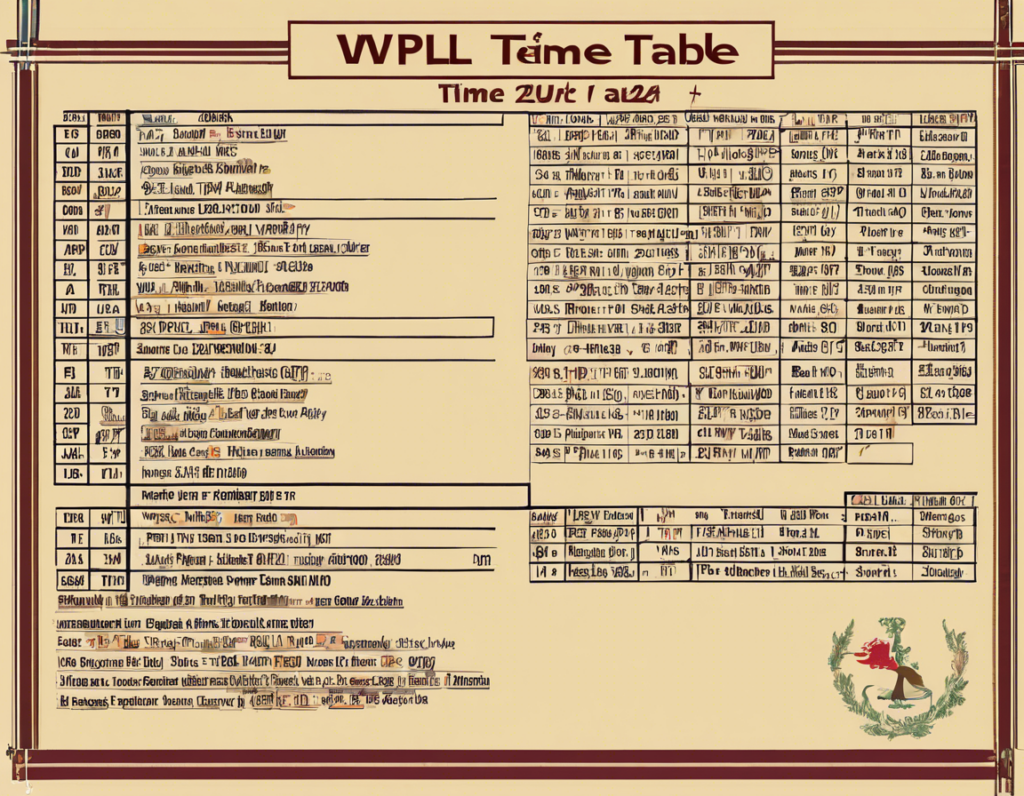Introduction
Planning a timetable may seem like a daunting task, but with the right tools and strategies, it can become a seamless and efficient process. In the world of project management, a well-structured timetable is crucial for keeping track of tasks, deadlines, and resources. One such tool that is widely used for creating and managing timetables is the WPL timetable. In this comprehensive guide, we will delve into the intricacies of the WPL timetable and provide you with all the information you need to make the most out of this powerful tool.
What is WPL Time Table?
WPL, which stands for Work Breakdown Structure (WBS), Planning, and Scheduling, is a methodological approach used in project management to create a detailed timetable for a project. The WPL timetable breaks down a project into smaller, more manageable tasks, assigns resources to each task, and establishes realistic timelines for completion. By using the WPL timetable, project managers can effectively plan, execute, and monitor the progress of their projects.
Benefits of Using WPL Time Table
- Improved Organization: The WPL timetable helps in organizing tasks in a systematic manner, making it easier for teams to understand their responsibilities and deadlines.
- Resource Allocation: By assigning resources to each task, project managers can ensure that resources are utilized efficiently and effectively throughout the project.
- Better Time Management: The WPL timetable provides a clear timeline for each task, enabling teams to prioritize their work and meet deadlines.
- Enhanced Communication: With a well-defined timetable in place, team members can communicate more effectively, as everyone is aware of the project timeline and expectations.
How to Create a WPL Time Table
Creating a WPL timetable involves several steps, including:
- Identify Project Scope: Begin by clearly defining the scope of the project and breaking it down into smaller, more manageable tasks.
- Create Work Breakdown Structure (WBS): Develop a hierarchy of tasks that need to be completed, starting from the highest level (project) to the lowest level (individual tasks).
- Assign Resources: Identify the resources (human, financial, material) required for each task and allocate them accordingly.
- Estimate Timeframes: Determine realistic timelines for each task, considering factors such as dependencies, constraints, and resource availability.
- Sequence Tasks: Arrange tasks in a logical order, taking into account dependencies and constraints.
- Monitor and Update: Continuously monitor the progress of the project, update the timetable as needed, and make adjustments to ensure that the project stays on track.
Tips for Effective WPL Time Table Management
- Regular Updates: Keep the timetable up to date by monitoring progress and making necessary adjustments.
- Collaboration: Encourage collaboration among team members to ensure everyone is on the same page.
- Flexibility: Be prepared to adapt to changes and unforeseen circumstances by building flexibility into the timetable.
- Clear Communication: Ensure that all team members understand their roles, responsibilities, and deadlines to avoid confusion.
- Use of Software: Consider using project management software to create and manage the WPL timetable more efficiently.
FAQs (Frequently Asked Questions)
- What is the difference between a Gantt chart and a WPL timetable?
-
A Gantt chart visually represents a project schedule, showing tasks, timelines, and dependencies, while a WPL timetable focuses on breaking down tasks into smaller components and assigning resources.
-
How often should the WPL timetable be updated?
-
The WPL timetable should be updated regularly, ideally on a weekly basis, to ensure that it reflects the current status of the project.
-
Can multiple team members access and edit the WPL timetable simultaneously?
-
Yes, with the use of project management software, multiple team members can collaborate on the WPL timetable in real-time.
-
What is the role of a project manager in managing the WPL timetable?
-
The project manager is responsible for creating, updating, and monitoring the WPL timetable, as well as ensuring that resources are allocated effectively and deadlines are met.
-
How can dependencies be managed in the WPL timetable?
- Dependencies in the WPL timetable can be managed by identifying task relationships, establishing precedence, and sequencing tasks accordingly.
In conclusion, the WPL timetable is an essential tool for effective project management, enabling teams to plan, execute, and monitor projects with precision and efficiency. By following the steps outlined in this guide and incorporating best practices for WPL timetable management, project managers can streamline their workflow, optimize resource utilization, and achieve project success.
